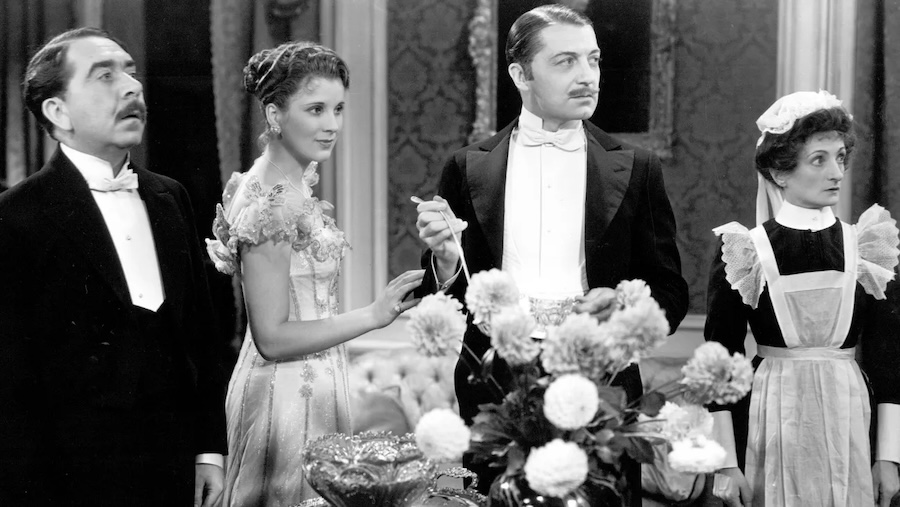
MAGNITUDE NEVER BEFORE ATTEMPTED. TITANIC IN ITS SWEEP. APPEALING TO EVERY EMOTION TO WHICH THE HUMAN HEART IS SUSCEPTIBLE.

The fact that Cavalcade is one of the lowest rated Best Picture winners on IMDb is not really a reflection on the quality of the film, but rather a sign of how little seen it is (and how unreliable those ratings are). I found a perfectly watchable copy on YouTube, but it’s obvious that you’ll have to get creative if you want to see Cavalcade, at least in my corner of the world. It was a spectacle in its day, covering decades and several historical events, the kind of experience you could only have in a cinema.
Celebrating New Year’s 1899
The story begins on New Year’s Eve 1899. No one knows what the century holds, but two families are about to go through tumultuous changes. Jane and Robert Marryot (Diana Wynyard, Clive Brook) live in a townhouse in London together with their young boys, Edward and Joey. Their butler is Alfred Bridges (Herbert Mundin), married to the maid, Ellen (Una O’Connor); they also have a daughter, Fanny. As they all toast the arrival of 1900, both Alfred and Robert are going to off to fight in the Boer War. While her boys are playing with tin soldiers, Jane is terribly worried for the safety of her husband.
In the end, both men return alive and well, pretty much in time for Queen Victoria’s death. That’s also when Alfred announces that he’s bought his own pub, partly with money provided by Robert. It looks like fortune is about to smile on the Bridges, but then disaster strikes…
Starting out as a play
Time passes in the film with a Medieval cavalcade serving as symbolism; life is indeed a journey and major historical events dot the road for us all. In the case of this film, Titanic and World War I are a few of those. Cavalcade as a play seems improbable, but that’s how it originated. In 1930, Noël Coward had just seen the premiere of an intimate play he had written, ”Private Lives”, when he started discussing doing the opposite – a huge, costly production, perhaps set in France during the revolution. After finally deciding on ”Cavalcade” and finding the right theater for such a technically complex endeavor, 22 sets were built and 400 cast and crew members hired.
The play, its premiere attended by King George V, was celebrated as not only a hit but a patriotic achievement by the Conservative Party who considered ”Cavalcade” great help in defeating Labour in the 1931 election. It really wasn’t that simple though. In both the play and the film adaptation, war is portrayed as senseless slaughter, especially in World War I, a conflict that tears lovers apart and cruelly robs mothers of their children; one of the film’s most famous scenes has Jane walking grief-stricken through Trafalgar Square in an excited crowd celebrating the armistice. The story is also very conscious of class, comparing how life treats the Marryots and the Bridges, criticizing how a difference between classes could jeopardize true love.
It’s hard not to be swept along by the soapish drama.
Visual effects and montages illustrate many of the great events during this 30-year long journey. The film moves rapidly and there’s a danger that some of these events are simply noted without having much of an impact on the story… but it’s hard not to be swept along by the soapish drama. Fans of Downton Abbey will undoubtedly appreciate Cavalcade.
Original Coward melodies, along with numerous songs and compositions covering 30 years envelop the film, adding to the emotion and nostalgia. In the end, there are also a few ingredients (Swearing! Gay couples!) that challenged the conservatism of the day. A film worth rediscovering.
Cavalcade 1933-U.S. 110 min. B/W. Directed by Frank Lloyd. Screenplay: Reginald Berkeley. Play: Noël Coward. Art Direction: William Darling. Cast: Diana Wynyard (Jane Marryot), Clive Brook (Robert Marryot), Herbert Mundin (Alfred Bridges), Ursula Jeans, Margaret Lindsay, Beryl Mercer, Una O’Connor.
Trivia: Co-produced by Lloyd. Frank Borzage was originally set to direct. Betty Grable can be spotted as an extra in a party sequence.
Oscars: Best Picture, Director, Art Direction.
